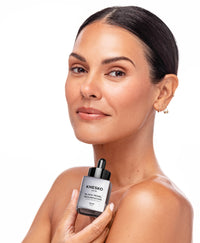Yes, lactic acid is important for skin because it brightens, hydrates, and smooths skin texture. It also reduces the appearance of fine lines, wrinkles, and dark spots. As a gentle alternative to other AHAs, lactic acid doesn’t just provide amazing skincare benefits—it’s also compatible with all skin types.
Here’s why you should consider incorporating it into your skincare routine.
What Is Lactic Acid?
But first, what exactly is this skincare ingredient?
Lactic acid is a type of alpha hydroxy acid (AHA). AHAs are water-soluble organic compounds that are naturally produced by the body when it breaks down carbohydrates for energy. As a skincare ingredient, it’s commonly derived from milk, but there are also vegan sources of lactic acid, like fermented corn starch, sugar cane, and beets.
This AHA offers unrivaled skincare benefits. Compared to other AHAs, lactic acid imparts powerful healing properties, all while helping the skin stay naturally hydrated.
Sale price
$82.00
What Are the Benefits of Lactic Acid?
Just like other AHAs, lactic acid is a chemical exfoliator. It breaks down bonds between dead skin cells during the natural process of cell turnover, which helps reveal a fresh complexion. At the same time, lactic acid can penetrate deeper levels of the skin, stimulating collagen production for firmer skin—especially at higher concentrations.
Lactic acid also offers unparalleled moisturizing properties compared to other AHAs. That’s what makes it the main ingredient for keratosis pilaris (KP) skincare solutions, as it helps to treat the rough patches of skin on the back of the arms by providing much-needed hydration.
After using lactic acid regularly, you’ll notice a brighter complexion and smoother skin. It’s one of the mildest forms of alpha hydroxy acid, so lower concentrations are safe to use on even the most sensitive skin.
Who Can Use Lactic Acid?
Lactic acid is a gentle (but potent!) form of AHA, so it’s suitable for almost everyone. If you’ve experienced irritation after using other AHAs, lactic acid might be the perfect solution to your skincare concerns.
It is composed of larger molecules than glycolic acid, so it doesn’t penetrate the skin as deeply. As a result, it’s less likely to irritate sensitive skin.
How Can You Add Lactic Acid to Your Skincare Routine?
When it comes to lactic acid, start slow. Cleansers, serums, and moisturizers are generally best reserved for nighttime use, and the suggested frequency will vary depending on the product and concentration. Make sure to check the packaging for specific usage instructions.
Even though lactic acid is a gentler AHA, you shouldn’t use it too frequently. You might experience slight tingling or redness as your skin adjusts to AHAs, but that’s normal.
Always follow up with a hydrating moisturizer to balance your skin. Like other AHAs, lactic acid increases your skin’s sensitivity to the sun, so don’t forget to apply SPF!
Enhance Your Skincare Routine with Lactic Acid
At KNESKO, we formulate luxurious, clean, high-quality skincare products. Revive your complexion and rehydrate your skin with our lactic acid face serum, infused with potent AHAs and PHAs to transform your skin from within.














